Korokke is a famous Japanese snack that captivates all food lovers with its golden, crispy crust and soft, rich filling. Instead of just enjoying it at a restaurant, why not try making this delicious dish yourself at home? Don’t miss this Kamereo article to get the authentic recipe, helping you easily master this attractive Korokke dish!
How to Make Beef Korokke (Potato Croquettes)
If you’re looking for a crispy, flavorful dish to change up your family meals, then beef Korokke is the ideal choice:
Ingredients
- Potatoes: 800g
- Ground beef: 200g
- Eggs: 6
- Onion: 1
- Unsalted butter: 2 teaspoons
- Panko breadcrumbs: 500g
- White cabbage: 50g (for garnish)
- Seasonings: salt, MSG, pepper, etc.
- Ketchup: 2 tablespoons
- Tonkatsu sauce: 3 teaspoons
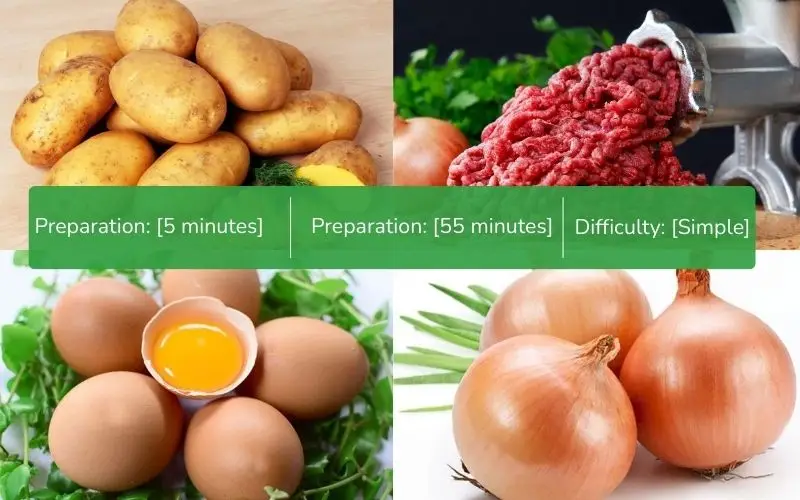
Instructions
To make delicious, crispy beef Korokke, follow these detailed steps:
Step 1. Prepare the ingredients:
- Potatoes: Peel thoroughly and cut into bite-sized pieces.
Small tip: To keep potatoes white, you should soak peeled potatoes in water mixed with a little dilute salt. Then rinse thoroughly with water and drain completely before boiling.
- Onion: Finely chop.

Step 2. Boil potatoes, boil eggs, and sauté beef:
- Boil potatoes:
- Place the prepared potatoes in a pot, adding water to cover the potatoes by about 3cm.
- Boil potatoes for about 15 – 20 minutes or until they are tender.
- Drain all the water, keeping the potatoes in the pot.
- Boil eggs: Place 4 eggs in a pot, cover with water, and boil for about 12 – 15 minutes until fully cooked. Then, remove the eggs and peel them.
Good tip: Boiling eggs with a little salt will make them easier to peel once cooked. Additionally, adding a little vinegar to the boiling water can help prevent the eggs from cracking during cooking.
- Sauté beef:
- Heat a pan over low heat.
- Add butter to the pan and melt completely, then sauté the finely chopped onion until fragrant.
- Once the onion is translucent, add the ground beef and sauté together.
- Season with half a teaspoon of salt and a little pepper to taste, then stir well until the meat is browned and seasoned.
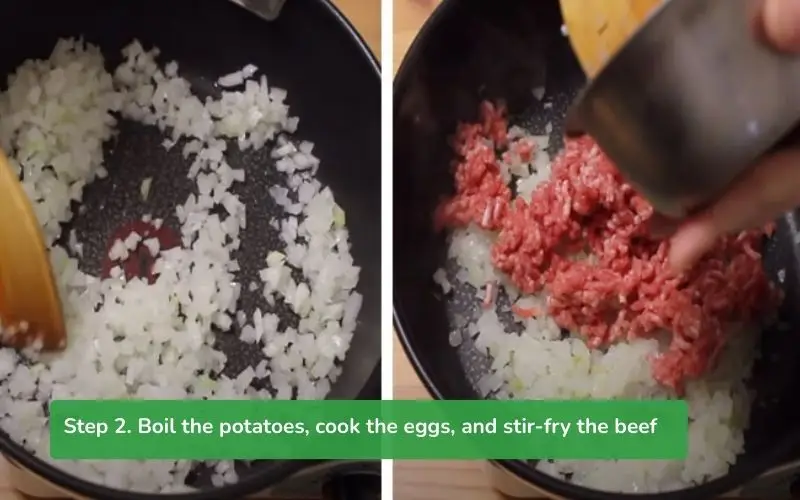
Step 3. Mix the ingredients:
- Process boiled eggs: After the eggs are cooked, separate the yolks and whites.
- Mash potatoes and yolks: Add egg yolks to the hot potatoes in the pot. Use a spoon or potato masher to mash and thoroughly mix the potato and egg yolk mixture.
Note: You should mash the potatoes while they are still hot so they are easier to mash and the mixture is smoother.
- Mix all ingredients:
- Dice the egg whites finely, then mix them with the mashed potato mixture.
- Next, add the sautéed beef and mix all ingredients thoroughly.
- Then, spread the mixture evenly on a flat surface.
- Divide the mixture into about 16 small triangular portions.
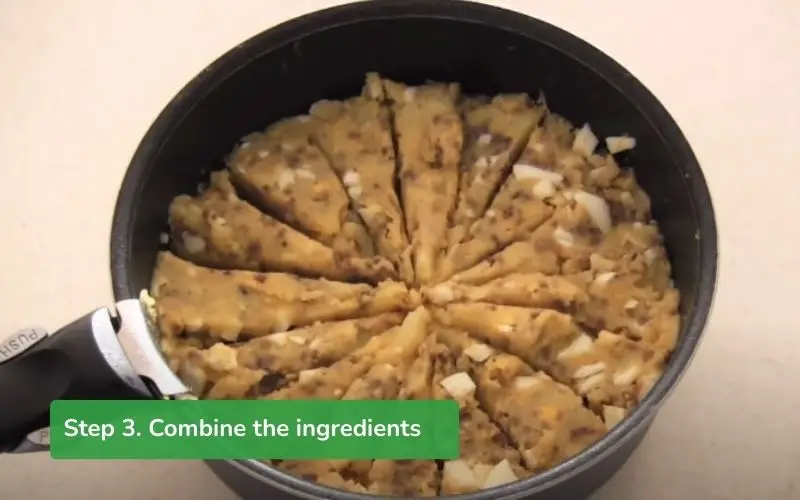
Step 4. Form and fry Korokke:
- Shape the croquettes: Take each divided portion, roll into a ball, and gently flatten.
- Coat with flour:
- Pour about 100g of all-purpose flour onto a tray to prevent sticking.
- One by one, coat each potato ball with a thin layer of all-purpose flour.
- Continue to roll the croquette through the beaten egg.
- Finally, roll the croquette evenly through the breadcrumbs.
- This layer of breadcrumbs will make the crust crispy when fried.

Step 5. Fry the croquettes:
- Pour a sufficient amount of cooking oil into a pan or small pot and heat it over high heat.
- When the oil is hot, slowly add the Korokke one by one to fry.
- Reduce heat to low, gently turn the croquettes until all sides are golden brown and crispy.
- Remove the croquettes to a plate lined with oil-absorbing paper.

Step 6. Make the sauce:
- In a small bowl, combine 2 teaspoons of sugar, 2 teaspoons of ketchup, and 3 teaspoons of Tonkatsu sauce, then mix all ingredients thoroughly.
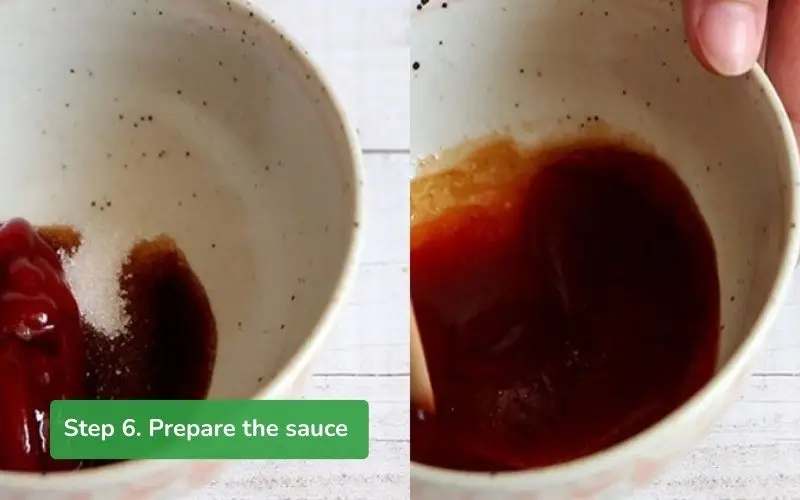
Step 7. Final product:
- Pour the sauce into a small bowl, and garnish the plate of Korokke with some shredded cabbage or cherry tomatoes.
- Beef Korokke, with its crispy outer shell encasing a creamy potato filling combined with beef and egg, will surely be hard to resist.
- The croquettes have a mild flavor, and when dipped in the sweet and sour sauce, they create a very harmonious and delicious taste.

How to Make Crab Cream Korokke (Potato Croquettes)
If you want to try a more unique variation of Korokke, let’s explore the unique crab cream Korokke recipe. This dish offers a rich, fragrant flavor from crab and cream, sure to satisfy even the most discerning palates.
Ingredients
- Crab meat: 60g
- Butter: 20g
- Onion: 60g
- Button mushrooms: 40g
- All-purpose flour: 25g
- Panko breadcrumbs: 100g
- Unsweetened fresh milk: 150 ml
- Salt: 1.5g
- Egg: 1/2
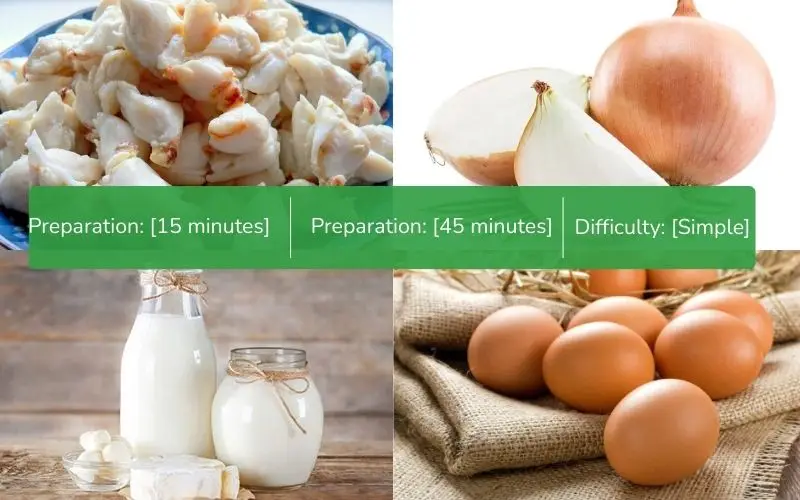
Instructions
Here are step-by-step instructions for making crab cream Korokke that you can refer to and easily follow:
Step 1. Prepare ingredients:
- Crab meat: If using fresh crab, after boiling, shred the crab meat with your hands until loose. Then, use scissors to cut the crab meat into smaller pieces.
Note: If using canned crab meat, drain all the liquid completely before shredding and cutting similarly.
- Onion and button mushrooms: Dice the onion and button mushrooms for the filling.
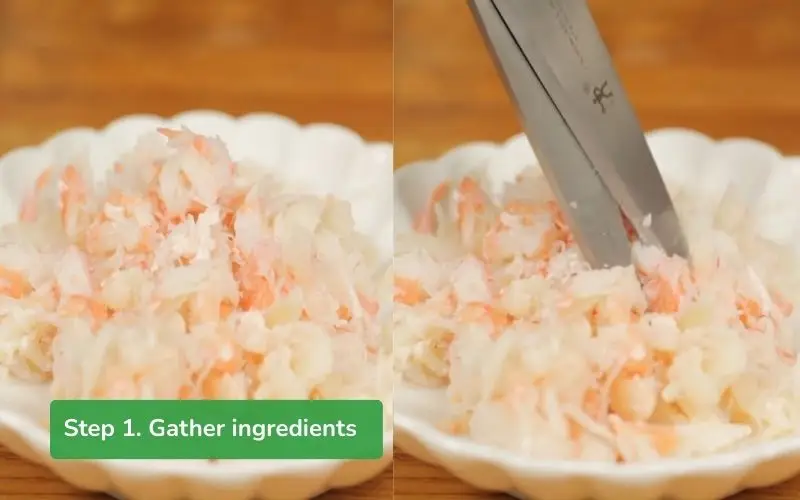
Step 2. Simmer cream sauce:
- Place a pan on the stove over medium heat. When the pan is hot, add butter and heat until the butter is completely melted and coats the pan.
- Once the butter has melted, add the diced onion to the pan, stirring until the onion begins to soften and become translucent.
- Next, add the sliced button mushrooms and sauté together.
- Sauté for about 3 more minutes until the amount of water in the pan reduces, the onion and mushrooms turn golden, and become fragrant. Then, reduce the heat to low and add the all-purpose flour, stirring until the flour is thoroughly cooked.
Small tip: All-purpose flour will help the filling be softer and have better binding than other types of pastry flour. When sautéing flour, you need to cook it thoroughly to eliminate the raw flour smell and create an attractive aroma for the filling.
- Turn off the heat and add all 150ml of prepared milk to the pan, stirring well until the mixture is combined.
- Then, turn the stove back on to high heat and continue to stir gently.
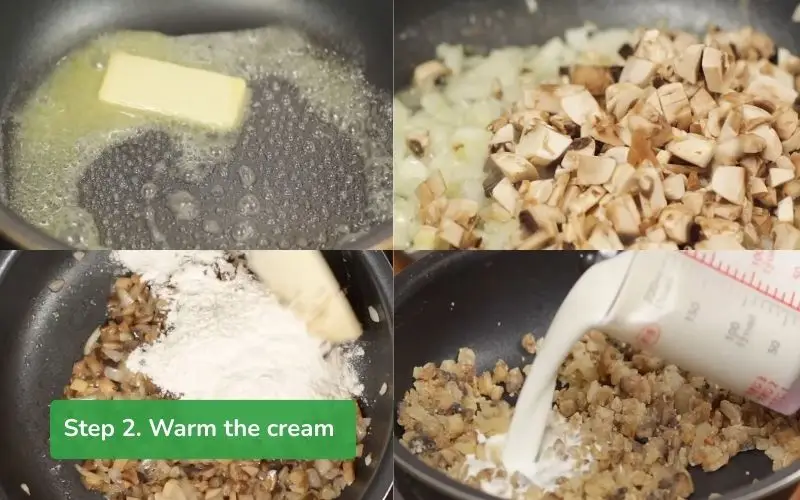
Step 3. Make the crab cream mixture:
- When the mixture is just hot, add all the crab meat, and season with salt and pepper to taste. Continue to stir the mixture evenly over high heat until it thickens.
- Once the mixture has thickened and has a smooth consistency, turn off the heat and transfer it all to a tray. Spread the mixture flat and cover tightly with plastic wrap. Then, place the tray in the refrigerator for the mixture to set completely.
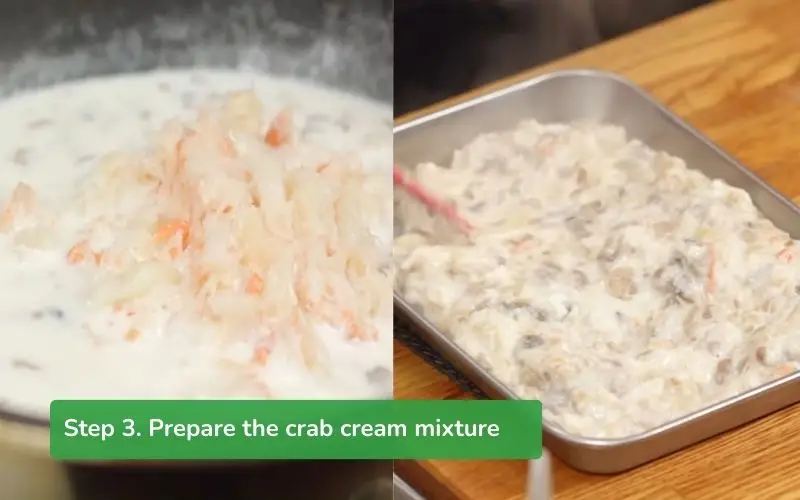
Small tip: Don’t forget to stir the mixture thoroughly and continuously to prevent it from burning and sticking to the bottom of the pan. Before transferring the mixture to the tray, lightly coat the tray with a thin layer of vegetable oil to prevent the filling from sticking and make it easier to remove.
Step 4. Shape the croquettes:
- Once the filling has been completely chilled, remove the tray from the refrigerator. Use a knife to cut the filling into 6 equal portions.
- Use your hands to shape each of the 6 portions into a round or oval shape, as desired.
Tip: When shaping the filling, grasp it firmly to press out all the air, avoiding any internal gaps. Otherwise, the croquette might explode during frying.
- After shaping the filling, place it in a bowl of all-purpose flour to coat it with a thin layer of flour. Place the croquettes into the bowl one by one, gently turning them with your hands so that the flour covers the entire surface of the croquette.
- After coating with the flour layer, continue to roll the croquettes through the beaten egg.
- Finally, place the croquettes in Panko breadcrumbs (or other breadcrumbs), using your hands to turn them evenly so that the breadcrumbs completely cover the croquettes.
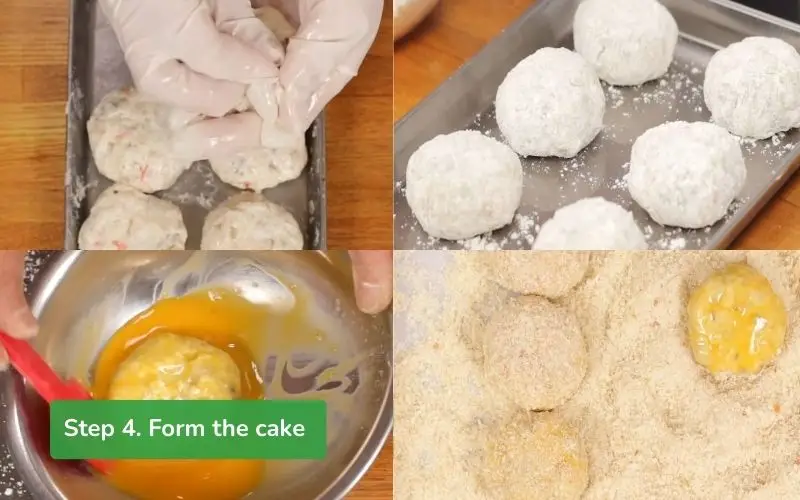
Note: Before coating the croquettes, the breadcrumbs should be finely crushed and sifted to remove large crumbs. This will help the breadcrumbs stick to the filling more easily and adhere evenly.
Step 5. Fry the croquettes:
- Place a pan on the stove, turn on high heat, and add plenty of cooking oil.
- Wait until the oil is very hot (ideal temperature is above 175 degrees C) then gradually add each Korokke to fry.
Note: Do not fry more than 3 croquettes at once as this will lower the oil temperature, leading to improperly fried Korokke. You can fry one at a time to ensure the oil temperature remains consistently high.
- When one side of the croquette is golden brown, gently flip it with chopsticks, being careful not to damage the coating.
- The total frying time is about 2 – 3 minutes until the croquettes have a beautiful golden color. Use a slotted spoon to remove the croquettes and place them on oil-absorbing paper to drain.
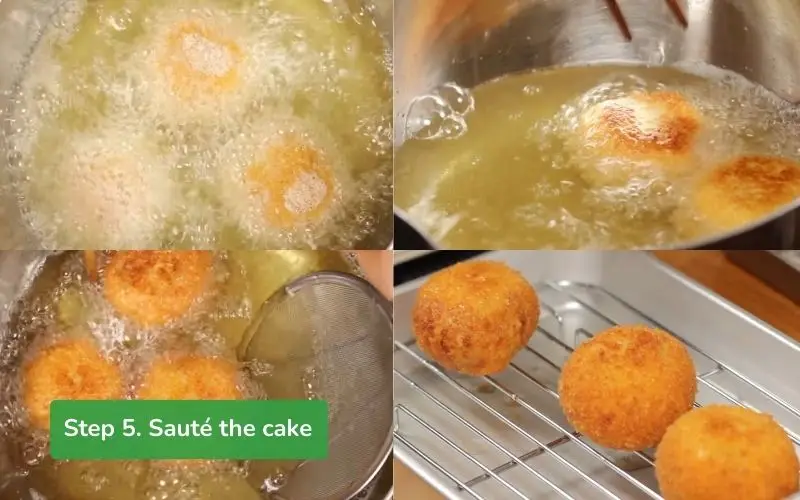
Step 6. Final product:
- Serve the crab cream Korokke on a plate with tomatoes and lettuce. You can dip the croquettes in chili sauce or ketchup, both are delicious. Crab cream Korokke, with its crispy crust and a rich, savory filling of milk and crab meat, is truly a wonderful and unforgettable snack.
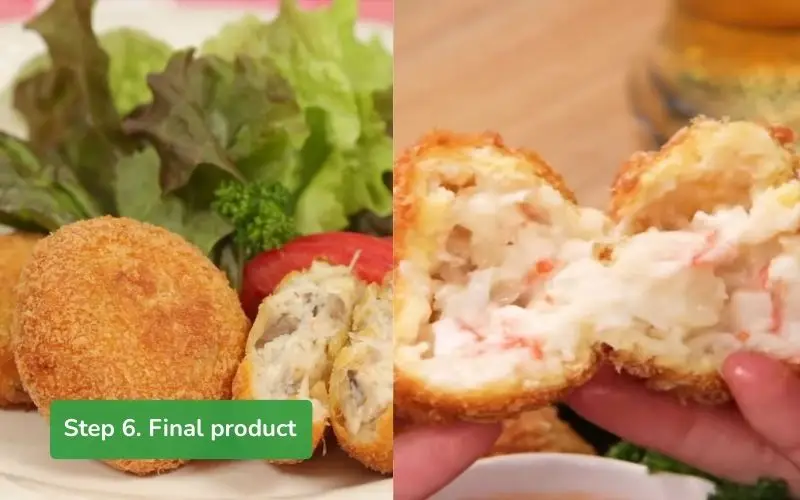
Kamereo – Your Supplier of Authentic Japanese Korokke at Great Prices
Kamereo is a specialized platform for supplying ingredients and kitchen tools to the F&B industry, committed to providing Japanese quality products at reasonable prices. As a direct partner of Gyomu Japan, Kamereo proudly distributes Japanese domestic standard items to F&B businesses in Vietnam, meeting the increasing demand for quality and reliability.
Buy high-quality, authentic Japanese Korokke at great prices from Kamereo:
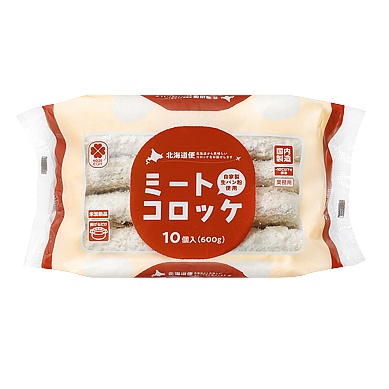
Frozen Meat Filled Korokke 600g / ミートコロッケ
99,000đ/PACK
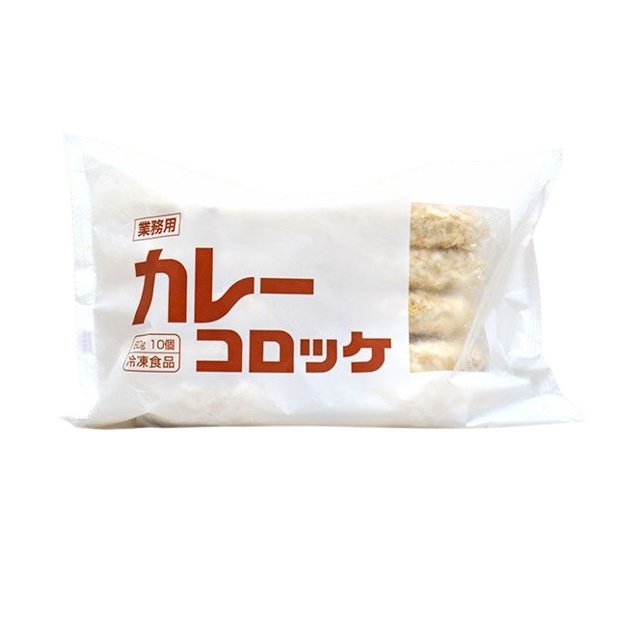
Korokke Frozen Curry Filled 600g / カレーコロッケ
99,000đ/PACK
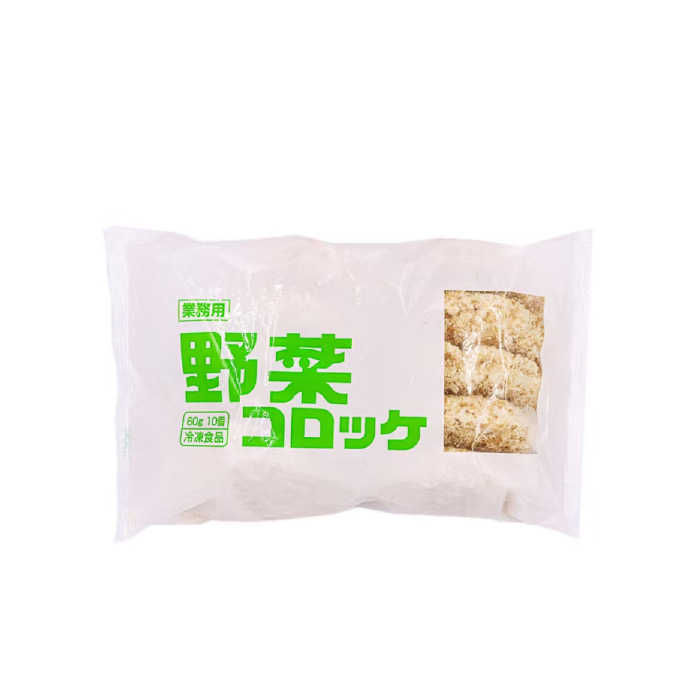
Frozen Vegetable Filled Korokke 600g / 野菜コロッケ
99,000đ/PACK
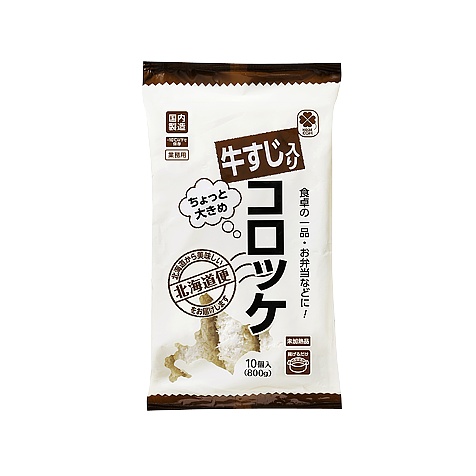
Frozen Beef Tendon Korokke 800g / 牛すじコロッケ
139,000đ/PACK
<button CTA>
To ensure consistent and stable quality, Kamereo always implements strict control procedures and a modern warehousing system from storage to transportation. With the goal of becoming a “One-stop supplier,” we also offer a diverse range of products including fresh food, frozen food, beverage ingredients, and various kitchen utensils.

The Kamereo website and app not only help F&B businesses easily place orders but also allow for multi-store management, order approval, cost tracking, and real-time data analysis. This enables customers to control business operations more efficiently, transparently, and proactively than ever before.
Especially, Kamereo also stands out for its flexible support policy: accepting orders until midnight and delivering before 6 AM the next day. This speed and proactivity help kitchens and restaurants maintain stable operations without supply interruptions – a vital factor in the F&B industry.
Frequently Asked Questions
What is Korokke?
What is Korokke called in Vietnamese?
In Vietnamese, Korokke is often known by the Vietnamese localized name “bánh khoai tây chiên giòn” (crispy fried potato cake). Originating from France (croquette), this dish was introduced to Japan in the early 1900s and quickly became a popular, common dish, immensely loved by the people of the Land of the Rising Sun.
What is special about the dipping sauce for Korokke?
The dipping sauce served with Korokke is usually Tonkatsu sauce or a special sauce made from ketchup, sugar, and other seasonings. The special feature of this sauce is the harmonious combination of light sourness, subtle sweetness, and savory notes, which helps balance the richness of the fried Korokke.
Can Korokke be made without potatoes?
Nowadays, with culinary creativity, there are also some variations of Korokke made without using potatoes. Instead, other ingredients such as crab meat combined with cream sauce (like crab cream Korokke), or other vegetables can be used to create the filling. However, no matter how they are varied, these versions still retain the appealing and characteristic flavor of Korokke.
Conclusion
We hope this article has helped you better understand how to make Korokke and how to prepare it in an authentic Japanese way. To make your dish even more perfect, don’t forget to choose quality ingredients from Kamereo – a reputable food and kitchen supply platform for the F&B industry. Also, be sure to read more great recipes and useful kitchen tips in our Food and Lifestyle section!
See more:



